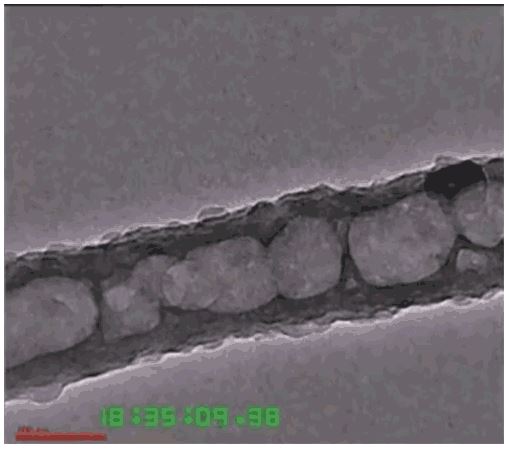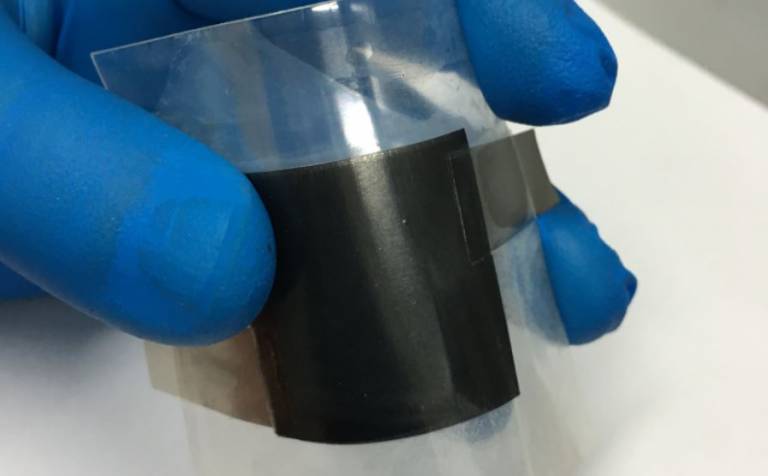(New electrode design may lead to more powerful batteries)
2020-02-03 マサチューセッツ工科大学(MIT)

・ MIT、香港理工大学、セントラルフロリダ大学、テキサス大学オースチン校およびブルックヘブン国立研究所(BNL)による研究チームが、安全な全固体電池開発の一環として金属リチウムを使用した 3D ナノ構造のアノードを開発。
・ 全固体電池では、リチウムイオン電池で使用される高揮発性で爆発の原因となり得る液体やポリマーゲルの電解質が不要なため安全性が確保できる。金属リチウムの電極と固体電解質による全固体電池の研究は他でも進んでいるが、いくつかの課題が残されている。
・ 大きな課題の一つが、金属リチウムの充電時の膨張と放電時の収縮による固体電解質の破損と、高反応性の金属リチウムに接触する固体電解質が化学的に不安定なことによる経時的な劣化。
・ これらの解決のために展開されている、金属リチウムへの完全な安定性を有する固体電解質材料の開発は困難となっている。今回、金属リチウムへの接触でも化学的に完全に安定する、2 種類の固体材料の MIEC(mixed ionic-electronic conductors)と ELI(electron and Li-ion insulators)を追加的に使用した特殊なアノード設計を開発した。
・ 六角形のMIECチューブのハニカム状アレイから成る 3Dナノ構造(チューブ直径は約100~300nm、高さは数十μm)内に部分的に注入された金属リチウムが電極を形成し、各チューブ内には余剰なスペースを残す。
・ 充電時にリチウムが膨張した際は、その固体結晶構造を維持しながらリチウムが液体のようにチューブ内の余剰なスペースに流れ込む。完全に閉じられたスペースに流入するため、充電時の膨張による圧力を軽減しながら電極形状と電極-電解質間の境界を維持する。ELI は、MIEC の壁と固体電解質層間の機械的なバインダーとして機能する。
・ MIEC によるハニカム構造の壁は化学的に安定しているため、リチウムとの電気的な接触を維持。充放電サイクル中の全固体電池の機械的・化学的な安定性を保持する。試験用デバイスによる 100 充放電サイクル後、固体電解質の破損が無いことを確認、概念実証に成功した。
・ 本研究は、米国立科学財団(NSF)が支援した。
URL: http://news.mit.edu/2020/solid-batteries-lithium-metal-electrode-0203
(関連情報)
Nature 掲載論文(アブストラクトのみ:全文は有料)
Li metal deposition and stripping in a solid-state battery via Coble creep
URL: https://www.nature.com/articles/s41586-020-1972-y
<NEDO海外技術情報より>
Abstract
Solid-state lithium metal batteries require accommodation of electrochemically generated mechanical stress inside the lithium: this stress can be1,2 up to 1 gigapascal for an overpotential of 135 millivolts. Maintaining the mechanical and electrochemical stability of the solid structure despite physical contact with moving corrosive lithium metal is a demanding requirement. Using in situ transmission electron microscopy, we investigated the deposition and stripping of metallic lithium or sodium held within a large number of parallel hollow tubules made of a mixed ionic-electronic conductor (MIEC). Here we show that these alkali metals—as single crystals—can grow out of and retract inside the tubules via mainly diffusional Coble creep along the MIEC/metal phase boundary. Unlike solid electrolytes, many MIECs are electrochemically stable in contact with lithium (that is, there is a direct tie-line to metallic lithium on the equilibrium phase diagram), so this Coble creep mechanism can effectively relieve stress, maintain electronic and ionic contacts, eliminate solid-electrolyte interphase debris, and allow the reversible deposition/stripping of lithium across a distance of 10 micrometres for 100 cycles. A centimetre-wide full cell—consisting of approximately 1010 MIEC cylinders/solid electrolyte/LiFePO4—shows a high capacity of about 164 milliampere hours per gram of LiFePO4, and almost no degradation for over 50 cycles, starting with a 1× excess of Li. Modelling shows that the design is insensitive to MIEC material choice with channels about 100 nanometres wide and 10–100 micrometres deep. The behaviour of lithium metal within the MIEC channels suggests that the chemical and mechanical stability issues with the metal–electrolyte interface in solid-state lithium metal batteries can be overcome using this architecture.



